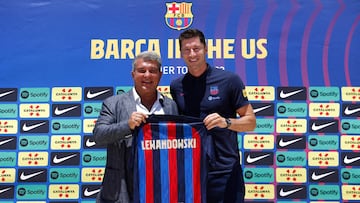How much money did LaLiga allow Barcelona to spend after selling club assets?
Having been the only club in LaLiga to be given a negative spending cap in March, Barça now have the second-highest in the Spanish league, behind only Real Madrid.

LaLiga this week revealed that Barcelona’s new spending cap is €656.42m - the second highest in Spain’s top flight, behind Real Madrid’s €683.46m. For Barça, that’s quite a recovery from March, when the previous financial figures announced by the Spanish league listed the club’s limit in negative numbers: €-144.3m.
What is LaLiga’s spending cap?
Officially known as the ‘limit on the cost of sporting squads’, LaLiga’s spending cap refers to the amount of money a club can commit towards assembling and maintaining their team that season, based on its financial incomings and outgoings. Devised in response to the economic woes suffered by a number of Spanish soccer teams in recent years, the financial-fair-play system applies to clubs in the top two tiers of Spain’s league pyramid, and takes into account money spent not only on the first-team set-up, but also the ‘B’ team and youth sides. The chief costs that come under the spending cap are the wages, bonuses and transfer fees that clubs pay for players, as well as coaches’ salaries.
Put simply, if teams try to make a signing or hand out a new contract that LaLiga deems they cannot afford, they will be barred from registering the player in question and, as a result, cannot field him in a competitive match.
Cap is retrospective amount
The cap announced by LaLiga every six months refers to the maximum that clubs were allowed to commit during the previous transfer window. The fact that the final figure is firmed up retrospectively goes some way to explaining why Barça - whose debts were last year estimated at €1.3bn - were able to sign players in January, despite incurring the only negative cap given to any club in Primera and Segunda División. Essentially, during the window LaLiga’s financial analysts believed the Blaugrana to be in a better financial place than they actually found themselves in once the mid-season transfer period closed. “Lower losses were estimated than the club finally suffered,” LaLiga corporate director Javier Gómez said.
Furthermore, the spending limits published by LaLiga are not completely hard and fast. If a club can show the league that they are making savings - e.g. by selling players - they are allowed to exceed their cap, but can only spend €1 for every €4 they save.
So how have Barça managed to flip their spending cap?
In part, the turnaround has happened because Barça have managed to bring in some transfer revenue and get several players off their wage bill over the summer. Although an €85m deal to sell Frenkie de Jong to Manchester United fell through - the Dutchman could not be persuaded to move to Old Trafford - Philippe Coutinho was sold to Aston Villa for €20m, Pierre-Emerick Aubameyang joined Chelsea for €12m, and Francisco Trincao was loaned to Sporting CP in exchange for a €3m fee. A number of other players have also departed the Camp Nou, either on loan or on free transfers.
However, the real difference-maker has been club president Joan Laporta’s activation of what have become known as his economic ‘levers’ - a process that has involved the selling-off of a number of major off-the-field assets in return for hundreds of millions of euros.
This began in late June, when Barcelona sold 10% of their LaLiga TV rights to the US investment fund Sixth Street, in exchange for just over €200m. At the end of July, the club then handed over another 15% of their TV rights to Sixth Street, who coughed up a further €400m. Lever number three was pulled in early August, when Barça sold a 25% stake in Barça Studios to Socios.com for €100m, before an additional 24.5% of the club’s in-house production company went to Orpheus Media in exchange for around €100m.

Levers crucial to Barça’s busy summer window
Laporta’s levers played a pivotal role in what proved a very active summer transfer market for Barcelona, who signed: Raphinha and Jules Koundé for €50m each, Robert Lewandowski for €45m, and Franck Kessié, Andreas Christensen, Héctor Bellerín and Marcos Alonso as free agents. Without the large-scale sale of assets, the club would not have been able to register all of their new signings. Indeed, all the cash it pulled in was still not enough to persuade LaLiga to let the club register Koundé in time for the start of the league season. The French defender, signed from fellow LaLiga team Sevilla in July, had to wait until week three before he was eligible to make his debut - and he was only able to do so after Barça directors dipped into their own pockets to loan the club the money it needed to avoid falling foul of the league’s financial rules.






